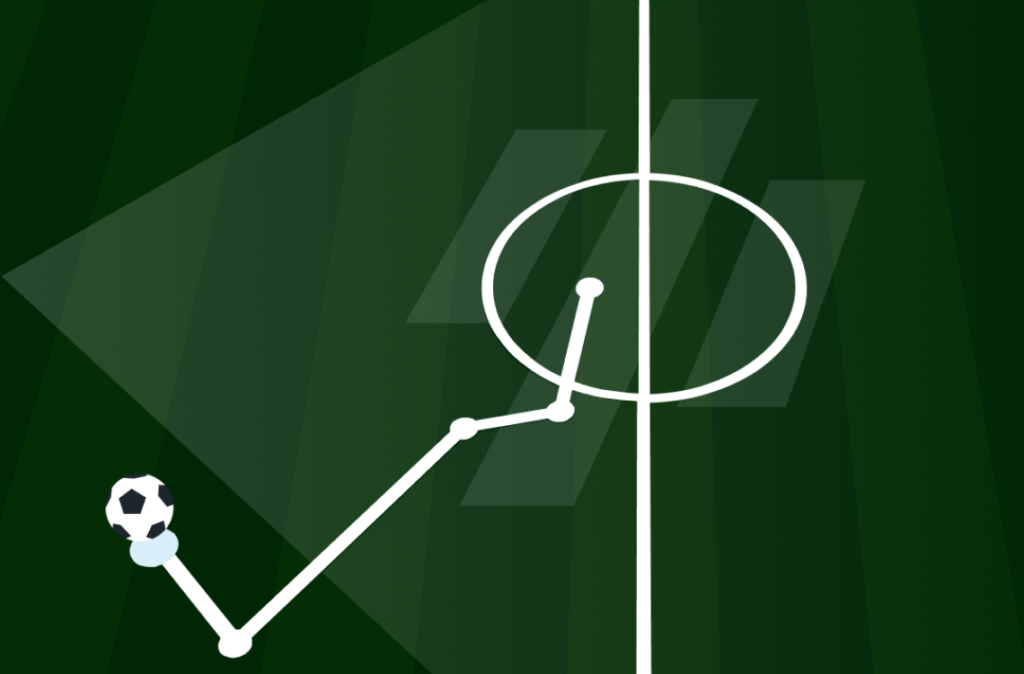Oli
Comprehensive B2B SaaS Virtual Assistant for Effortless Guest Engagement.

Details
Oli revolutionises guest services with its AI-powered virtual concierge, providing a seamless and personalised experience. Accessible via popular communication channels like SMS, voice assistants, and email—without requiring extra app installations—Oli ensures effortless guest interactions. Operating 24/7, it swiftly responds and assigns requests to the right team member, guaranteeing prompt and effective attention. By capturing detailed insights into guest preferences and collecting feedback more efficiently than traditional methods, Oli enhances service efficiency and enriches the overall guest experience.
In my year with the product, I’ve made a notable impact by refining the guest experience through AI-driven insights. I’ve led initiatives to streamline communication channels. Additionally, I played a key role in improving the virtual concierge’s responsiveness and request management, while also enhancing feedback collection and preference analysis to drive service improvements.
Client
Kmeleon
Tasks
Research / User Experience / User Interface / User Testing / Prototyping / Design System
Timeline
4 months
Streamlining Guest Interactions with Centralised Chat Management
In the dynamic environment of hotel guest services, efficient communication is critical. At Oli, we encountered a significant challenge: fragmented access to guest chats and profiles. Staff struggled to manage interactions effectively, as chat histories and guest information were dispersed across different sections.
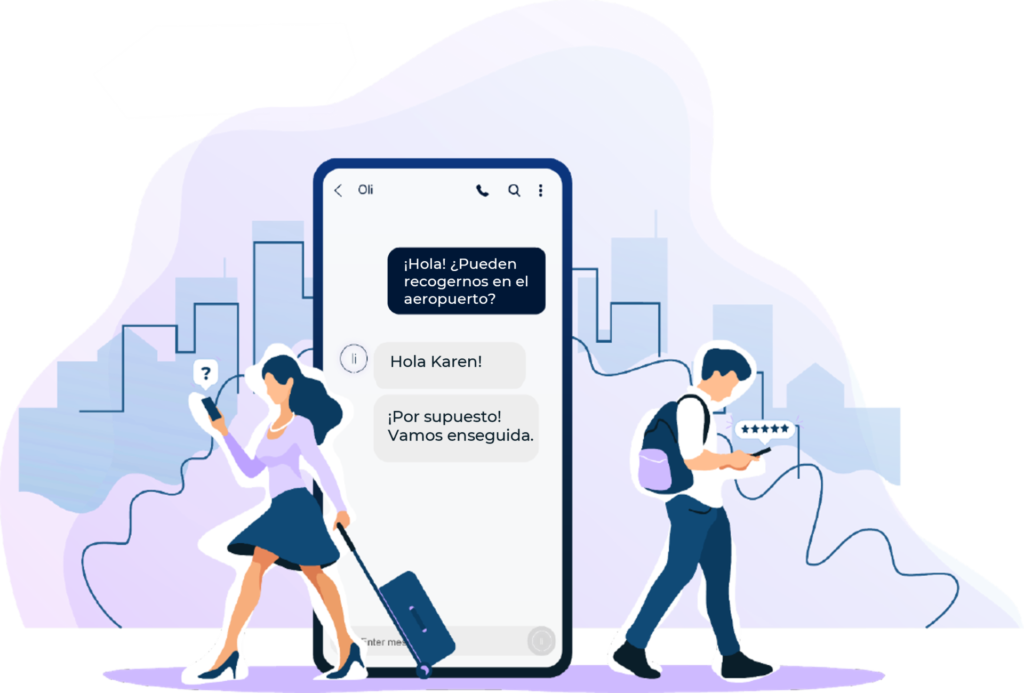

This inefficiency became particularly problematic when the AI chatbot could not fully address guest queries and required prompt human intervention. The disjointed system not only delayed response times but also hindered the quality of service, affecting overall guest satisfaction and operational efficiency.
Problem
Oli’s guest communication system had a fragmented user experience, with chat interactions and guest profiles separated in the Reservations section. This setup led to inefficiencies for staff, making it harder to access and respond to guest queries quickly, which reduced the effectiveness of the AI chatbot and negatively impacted the overall guest experience.
Solution
Uncovering Insights Through Collaboration
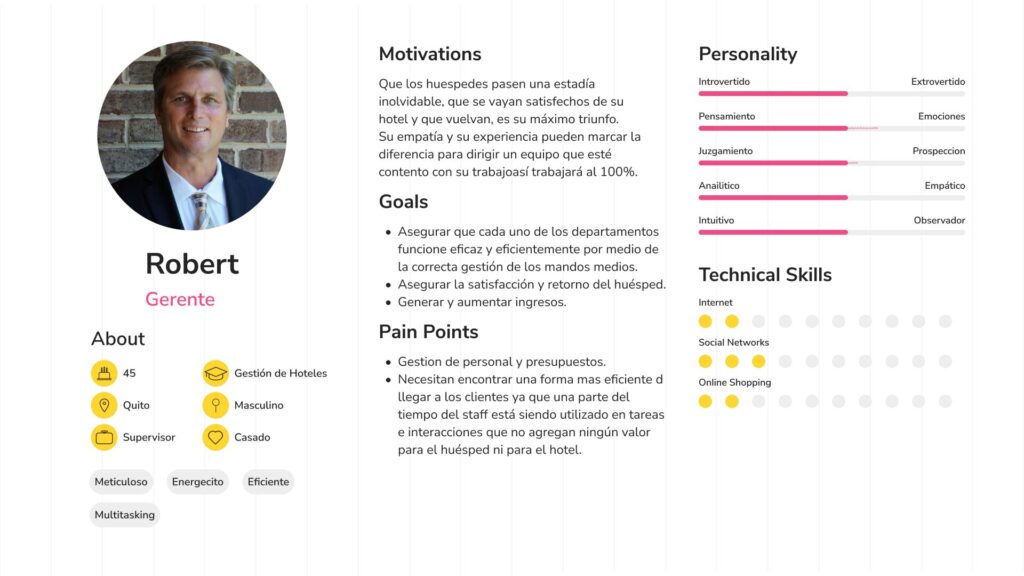
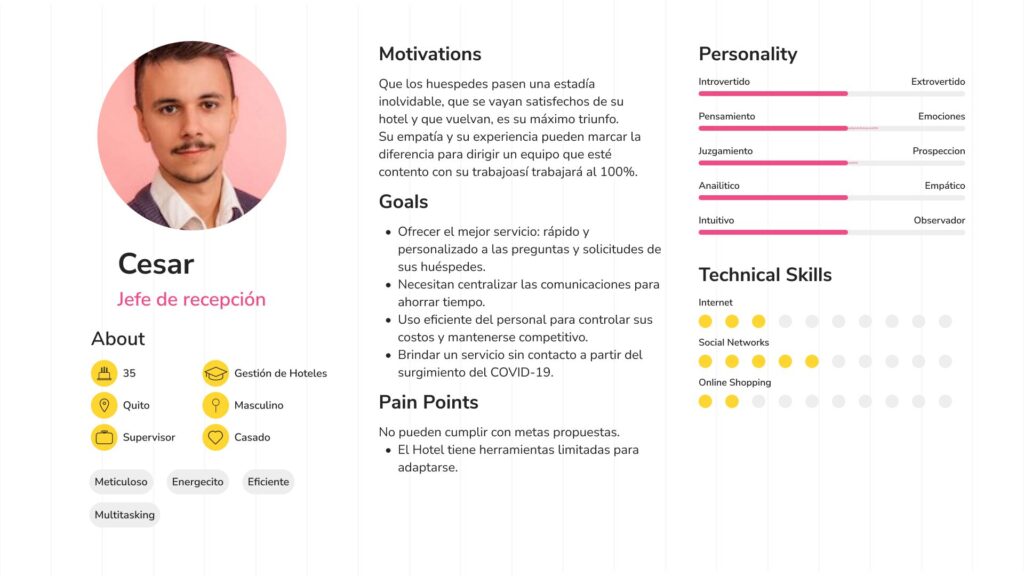
Workshops and Interviews
In our workshops and interviews, it became apparent that the ability to efficiently access and manage guest chats was crucial. The AI chatbot, while effective, did not always have all the answers and required human intervention for certain queries. This made the need for a streamlined chat access system even more pressing.
Key Insights:
- User Roles and Goals: Identified that Concierge Services Manager, Food and Beverage (F&B) Manager, Front Office/Guest Services Manager needed seamless access to chat histories and guest profiles to handle inquiries that the AI could not resolve autonomously.
- Pain Points: The fragmented system, with chats and guest information spread across different sections, hindered quick responses and effective management of guest interactions.
- Stakeholder Concerns: Staff were struggling with inefficiencies caused by the disjointed access to chat and profile information, while managers were focused on ensuring swift and accurate responses to guest inquiries, particularly when the AI fell short.
Collaborative Approach:
Stakeholder Management:
Gaining approval for the proposed changes involved thorough engagement with stakeholders. We facilitated workshops and one-on-one discussions with frontline staff and managers to gather feedback and build consensus. This ensured that all concerns were addressed and that the solution aligned with the needs of both users and decision-makers.
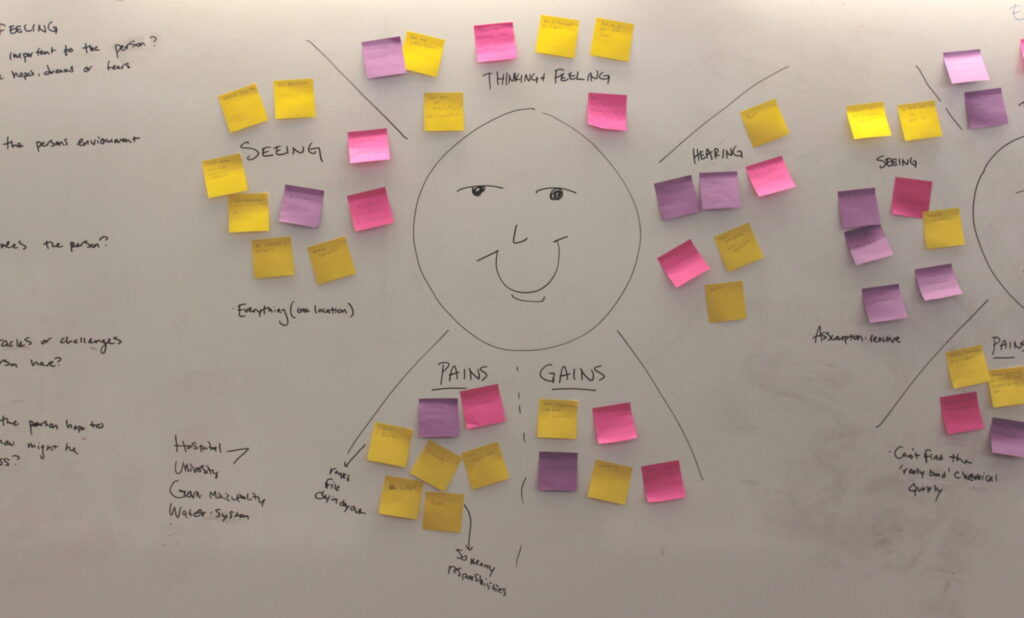
Analysis of the current Design Issues
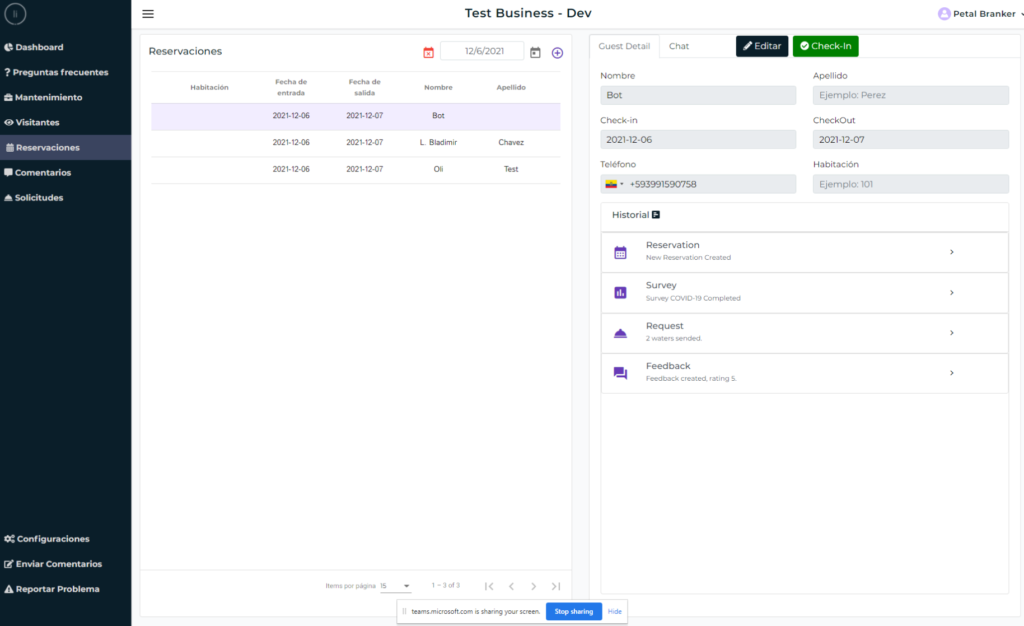
Strenghts
Integrated Communication
Feature a real-time chat system that allowed staff to engage directly with guests.
This was a significant advantage in terms of improving customer service and addressing guest needs quickly.
Personalized Interactiont
The inclusion of a guest profile picture and personal details made the system feel more human and engaging.
It helped staff recognize and build a connection with guests, which is a crucial part of the hospitality experience.
Compact Information Display
The design allowed for simultaneous viewing of guest details and communication history.
This layout supported multitasking and offered quick access to essential information.
Areas for Improvement
Cluttered Interface
With chat, guest details, and history squeezed into one view, it could overwhelm users and make navigation difficult.
Impact: Important information could be overlooked or require more effort to find, slowing down the workflow.
Lack of Distinct Visual Hierarchy
Lack of clear visual cues to distinguish different types of information. This made it harder for users to quickly scan and process the data.
Impact: Users needed to spend more time deciphering where to focus, which could reduce efficiency, especially during busy periods.
Limited Filtering and Search Options
The system didn’t provide filtering tools to sort or search through reservations efficiently.
The system didn’t provide filtering tools to sort or search through reservations efficiently.
Impact: This made managing large volumes of data more cumbersome and time-consuming, as users couldn’t quickly narrow down the information they needed.
Defining the solution
Insights
Introducing Conversations Section
- Objective: Centralise guest communication management to improve efficiency and response times.
Functionality: A dedicated section within the dashboard that consolidates all ongoing and historical conversations with guests.
Impact: Reduces time spent navigating between different sections, allowing staff to quickly access and manage all guest communications, leading to faster resolution of inquiries.
Department-Specific Chat Routing
- Objective: Ensure that guest inquiries are handled by the most appropriate department, improving service quality.
- Functionality: Automated categorization and routing of chats to relevant departments such as reservations, maintenance, or spa, based on the content of the guest's message.
- Impact: Facilitates faster and more accurate responses by directing queries to the correct team, reducing the need for manual reassignment and improving service delivery.
Streamlined Guest Management
- Objective: Improve the user experience for hotel staff managing guest interactions, leading to more efficient operations.
- Functionality: A streamlined interface that reduces the cognitive load on users by consolidating tools and information needed for guest communication into a single, easy-to-navigate section.
- Impact: Increases productivity by simplifying the process of managing guest interactions, reducing errors, and enhancing the overall speed and effectiveness of guest service.
Suggested AI Responses
- Objective: Streamline the response process by providing quick, consistent answers to common guest questions.
- Approach: A library of pre-crafted replies that staff can use or customize when responding to frequent inquiries, integrated directly into the chat interface.
- Impact: Saves time for frontline staff, reduces response times, and ensures consistency in guest communications, improving overall efficiency and guest satisfaction.
Centralised Guest Information Access
- Objective: Provide staff with comprehensive access to guest profiles and history for more personalized service.
- Functionality: Integration of guest data within the chat interface, including past interactions, preferences, and reservation details, accessible during the conversation.
- Impact: Enhances the ability of staff to deliver personalized service, increases the relevance and accuracy of responses, and improves guest satisfaction by making every interaction informed and contextually aware.
Prioritisation: Severity risk
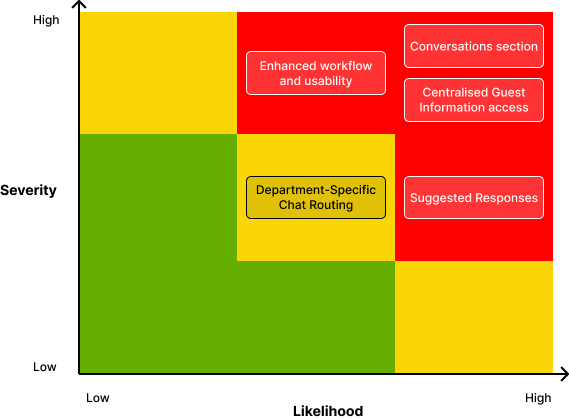

Feedback and Constraints:
Based on feedback from engineers and stakeholders, it became clear that the immediate implementation of a separate “Conversations” section would require significant system changes and was not feasible within the current timeframe.
Final Solution:
A quicker, more feasible approach was developed by enhancing the existing “Reservations” section to better handle conversations. This included features such as suggested responses and improved organisation of conversation-related data.
Impact of My Decision:
- Compromise: By suggesting a quicker solution, I was able to find a middle ground between what the engineers were comfortable with and what would benefit the users.
- Efficiency: The chosen solution still aimed to improve the management of guest conversations, even if it didn’t involve the ideal setup of a dedicated section.
- Stakeholder Alignment: Prioritising the quicker solution helped align the project goals with the capabilities and preferences of the engineering team, ensuring that improvements could be delivered without significant delays.
Ideation and Sketching

Sketches and Prototypes:
- Revised Wireframes: Updated wireframes reflected the integration of conversation management into the “Reservations” section. These designs included visual elements for conversation threads, suggested responses, and quick access to guest information.,
- Prototyping: Interactive prototypes were created to demonstrate how the enhanced “Reservations” section would function, showcasing the new features and workflow improvements.
Chat Flow
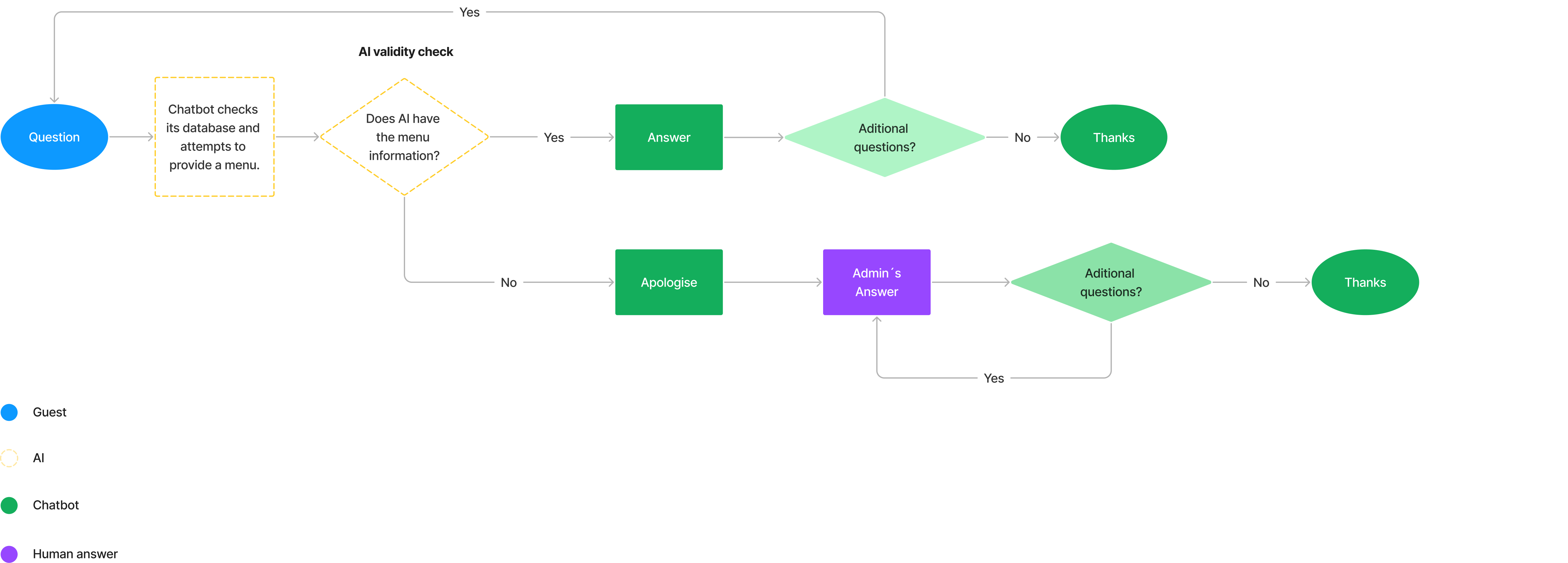

Testing and validation
Objective
To evaluate whether embedding chat functionality within the “Reservations” section enhances staff efficiency in managing guest communications, minimizes task-switching, and accelerates response times.
Test Outline
Participant Selection
I recruited 10-12 hotel staff members, including Concierges, Front Desk personnel, and Guest Services representatives, all of whom regularly engage with the reservations and messaging systems.
Scenario-Based Tasks
Participants completed tasks simulating common guest inquiries, necessitating access to guest profiles, reservation details, and message responses.
Metrics to Capture
- Time on Task: Record the duration taken to complete each task.
- Task Success Rate: Determine the percentage of tasks completed successfully without error.
- Click Count: Count the clicks required to access necessary information.
- User Satisfaction: Conduct a post-task questionnaire to gather feedback on usability and overall experience.
Post-Task Interviews
After task completion, I conducted interviews to collect qualitative feedback regarding:
- The ease of using the embedded chat within the “Reservations” section.
- Participants’ perceptions of the impact on response times and workflow efficiency.
- Suggestions for further improvements or additional features.
Validation Metrics
Success criteria included:
- Achieving an 80% or higher task success rate among participants.
- Notable reductions in response times compared to pre-test benchmarks.
- Positive feedback on usability and perceived efficiency improvements.
Results & Iteration
Based on the findings, I identified key areas for refining the chat functionality and interface design. I implemented necessary adjustments and planned follow-up tests to validate the improvements. This structured testing approach ensured the integration met user needs and supported more efficient guest service.
Before
After

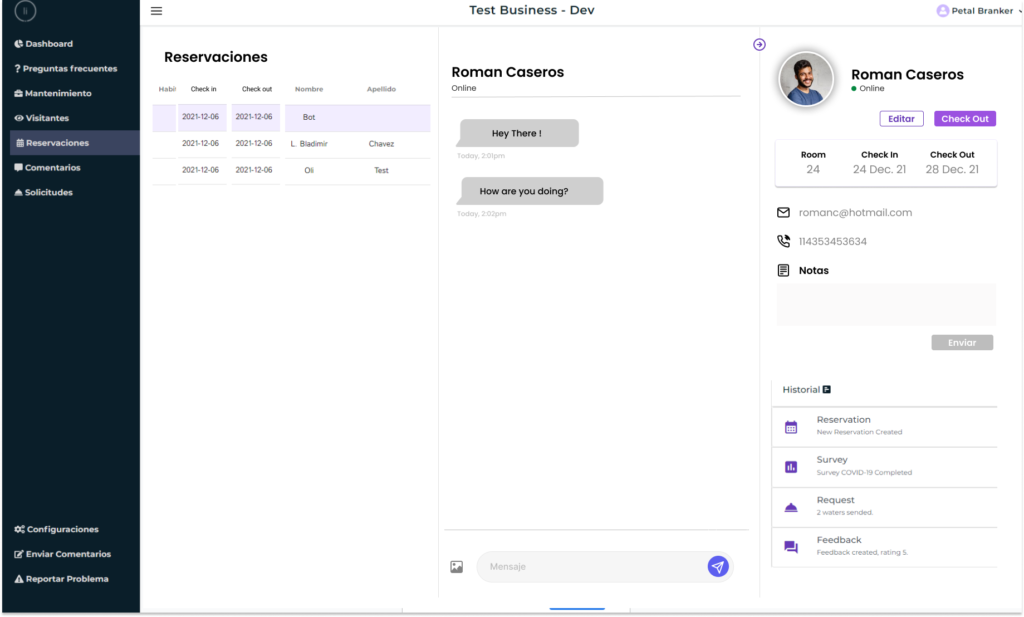
- Objective: To streamline the process of managing guest communications by embedding chat functionality directly into the existing “Reservations” section.
- Functionality: Staff can now access, track, and respond to guest conversations without leaving the reservations interface, reducing the need to switch between multiple sections.
- Impact: Improved efficiency in handling guest queries, leading to quicker response times
Learnings: The Journey of Iteration and Discovery
Efficiency Gains
Participants demonstrated significantly reduced task completion times when managing guest communications directly within the "Reservations" section, validating our objective of streamlining workflows.
Usability Feedback
Most users found the embedded chat feature intuitive, enhancing their ability to quickly access necessary information without the frustration of switching contexts.
Areas for Improvement
While the overall response was positive, users suggested enhancements such as more customizable suggested responses and clearer visual cues to further improve navigation.
Enhanced Communication:
The ability to manage guest interactions more seamlessly led to higher satisfaction scores from participants, highlighting the importance of integrated communication tools in service settings.
Success and Outcomes
Iteration: Conversations section and Department Routing
Refining the Legacy Workflow: Improving Responsiveness and Guest Satisfaction
During the exploration and definition phases, I identified key inefficiencies:
- Delays in resolving guest queries.
- Lack of interactivity in the process.
- No feedback mechanisms to track satisfaction.
To address these, I redesigned the workflow to include:
- Dynamic routing for faster query resolution.
- Immediate feedback collection to ensure guest satisfaction.
- Simultaneous escalation to avoid delays.
This approach improved the legacy system while keeping it familiar and aligned with guest expectations.
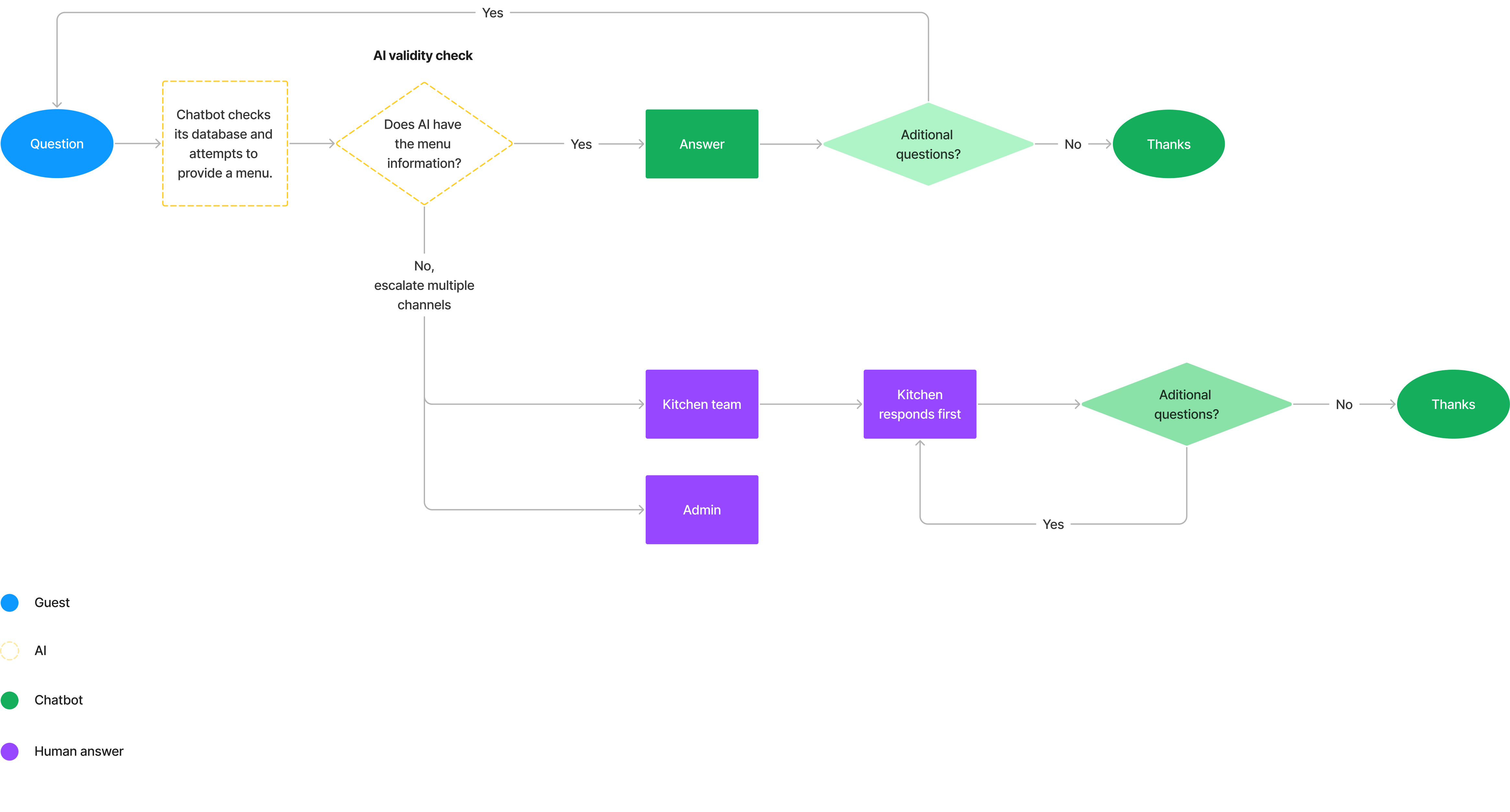
Designing an AI-Driven Workflow: Dynamic, Feedback-Oriented Solutions
Using insights from the discovery phase, I collaborated closely with engineers and stakeholders to design a future-focused workflow. Their input was crucial in refining the AI-centric solution to ensure its feasibility, scalability, and alignment with business objectives.
Key features include:
- Dynamic query routing for faster response times.
- AI-powered automation to reduce human dependency.
- Real-time feedback loops to measure guest satisfaction.
- Iterative structure for continuous learning and optimization.
This solution is scalable and adapts to complex user needs while enhancing efficiency.
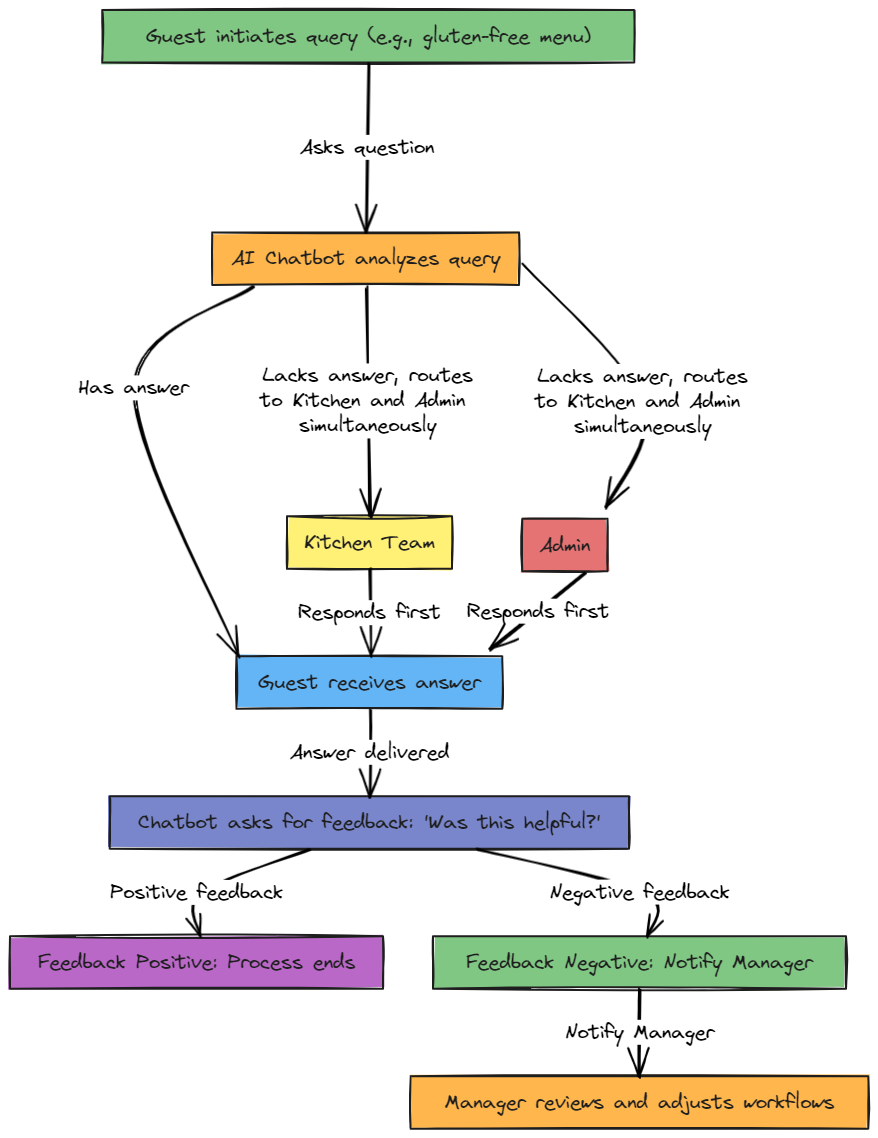
Department routing

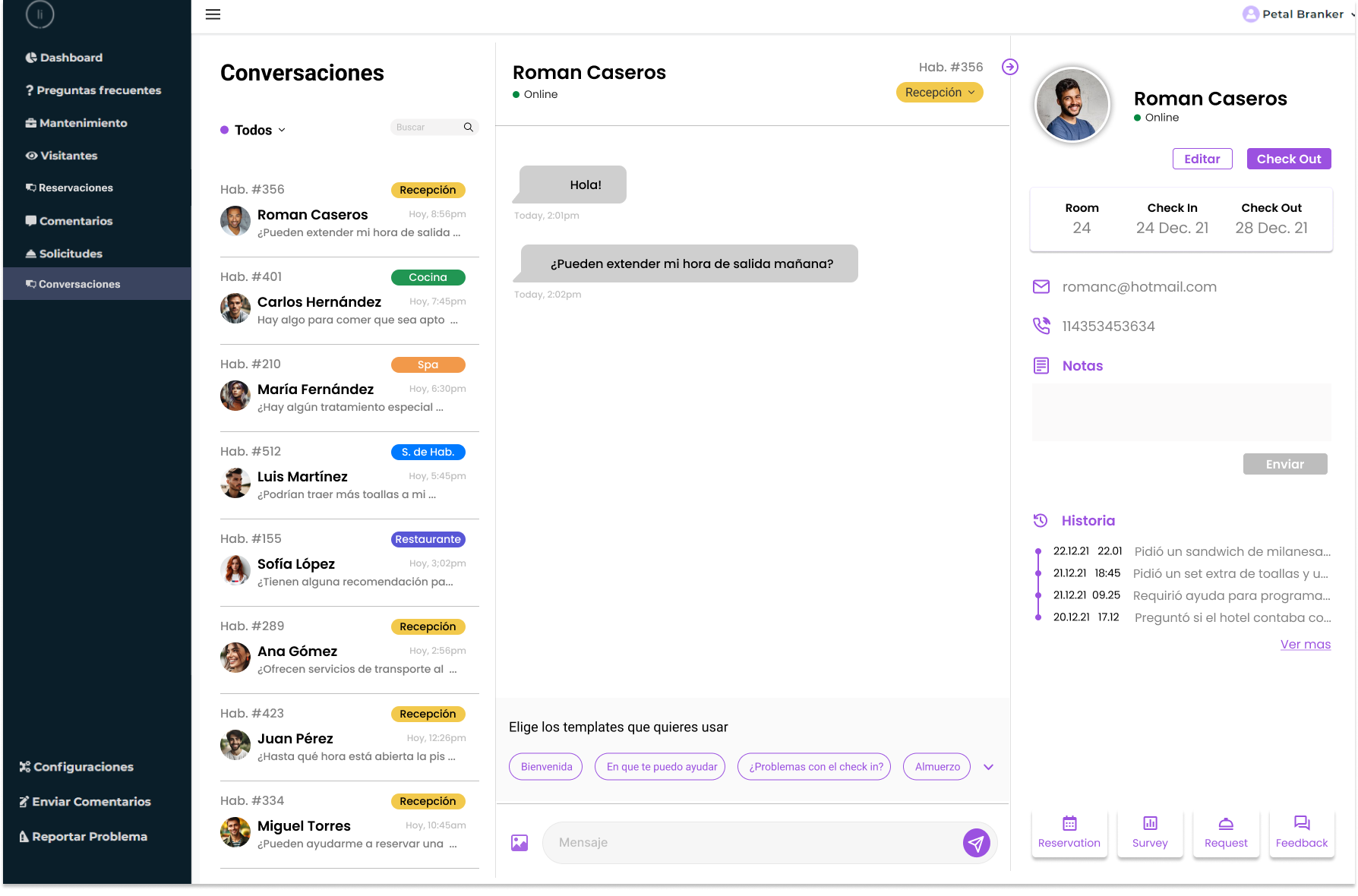
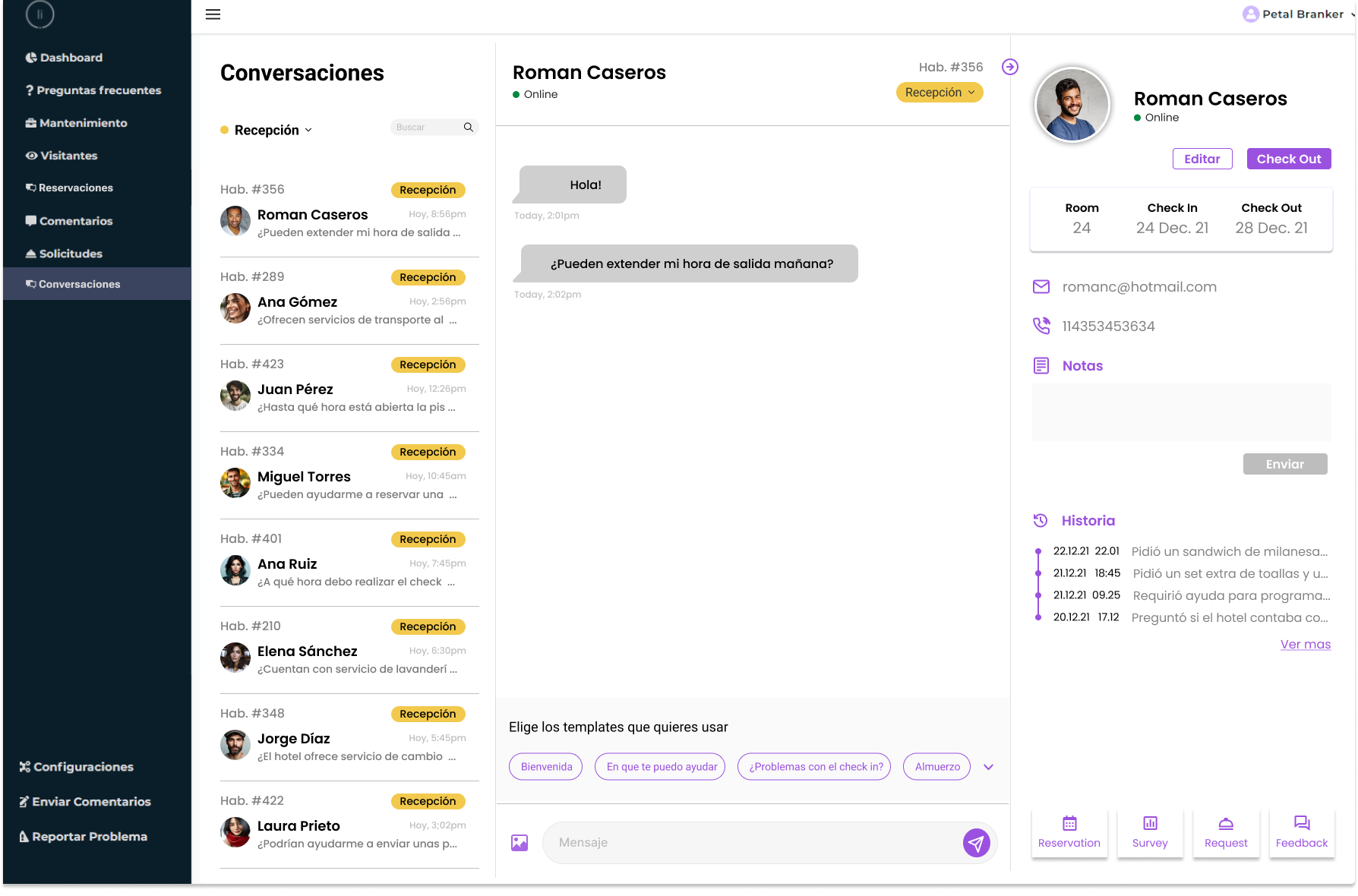
Usability Testing Summary
Objective:
The usability testing aimed to validate the redesigned communication system, focusing on the newly implemented “Conversations” section, role-based tagging, suggested responses, and overall user satisfaction.
Testing Overview:
- Participants: 10 staff members from various departments, including Front Desk, Reservations, and Management.
- Duration: Each session lasted approximately 60 minutes, comprising 45 minutes for task completion and 15 minutes for feedback and discussion.
- Method: Remote usability testing conducted via screen sharing and video conferencing tools.
Testing Procedure:
Tasks Included:
- Navigating to the “Conversations” section and locating a specific conversation.
- Applying role-based tags and routing conversations to the appropriate departments.
- Using suggested responses to reply to common guest inquiries.
- Accessing guest profiles and relevant information quickly.
- Providing feedback on overall user experience and satisfaction.
Outcomes and recommendations
Strenghts
High Task Success Rate
90% of participants successfully completed all assigned tasks, indicating strong usability and intuitive design.
Efficient Navigation
Participants reported that navigating the new "Conversations" section was straightforward, with an average time of 3 minutes to locate conversations.
Effective Role-Based Tagging
85% of participants found the role-based tagging feature useful for directing inquiries to the correct
Usefulness of Suggested Responses
80% of participants felt that suggested responses significantly reduced their response time for common inquiries, with an average response time of 1 minute per message.
Areas for Improvement
Minor Confusion with Suggested Responses
A few participants expressed confusion when editing suggested responses, indicating a need for clearer instructions or tooltips.
Integration with Existing Systems
Some staff noted that while the new features were helpful, there was still some difficulty switching between the "Conversations" and "Reservations" sections, suggesting a need for smoother integration.
Conclusion:
The usability testing successfully validated the redesigned communication system, demonstrating its effectiveness in streamlining guest interactions and enhancing staff efficiency. The positive feedback and high success rates affirm that the new features align well with user needs, while the identified areas for improvement will guide future iterations. The insights gained from this testing will play a crucial role in optimising the system for an even better user experience moving forward.
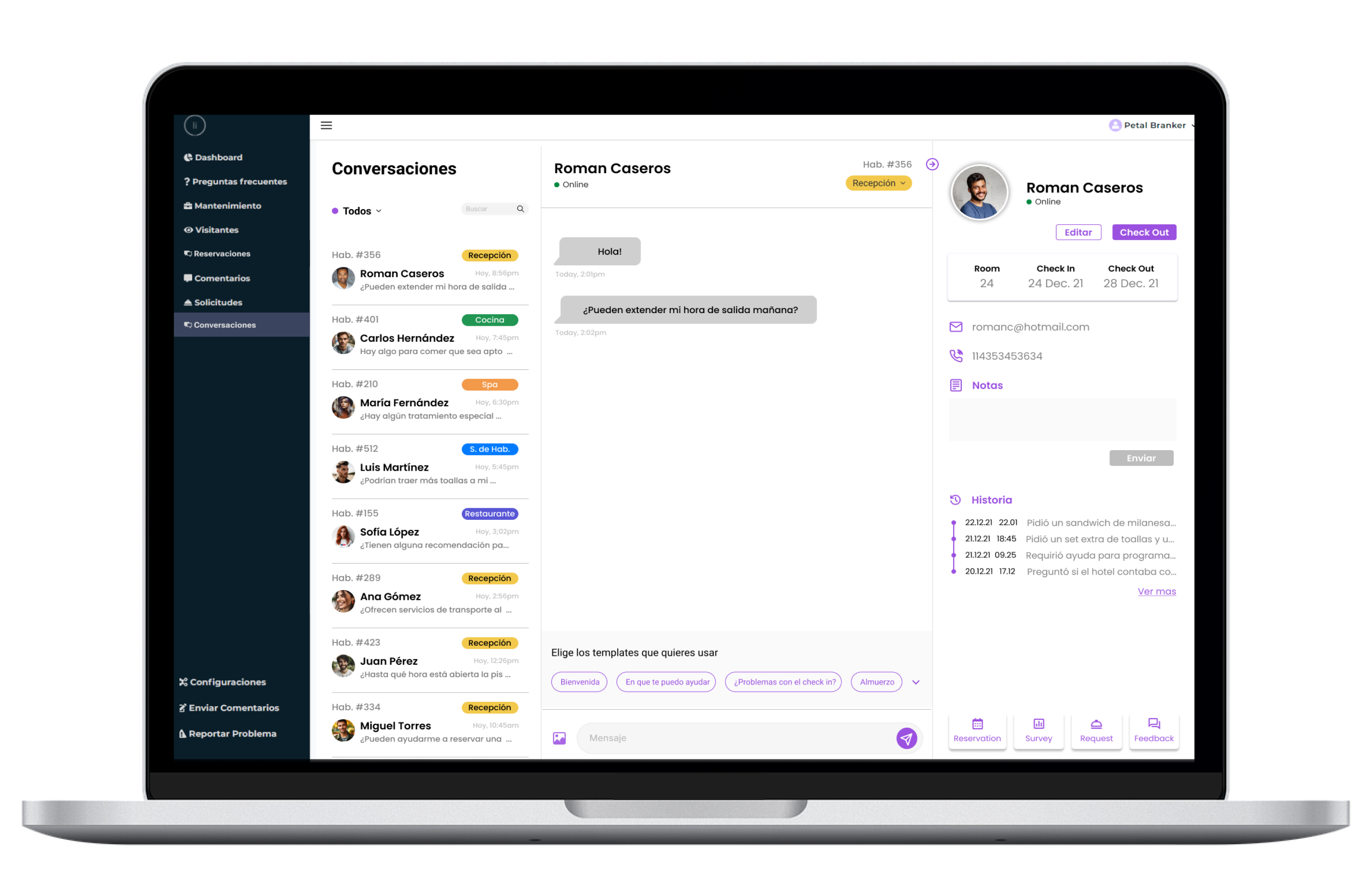
Success and Outcomes
Key Improvements
Centralised guest communications into a dedicated “Conversations” section, streamlining interaction management and improving staff efficiency by reducing the need to navigate between multiple sections.
Introduced role-based tags for departmental routing, enabling more accurate and efficient handling of guest inquiries by ensuring that conversations are directed to the appropriate team members.
Integrated suggested responses within the communication platform, saving time and ensuring consistency in guest interactions by providing staff with pre-crafted replies for common inquiries.
Enhanced the existing “Reservations” section to better accommodate ongoing conversations, allowing for a smoother transition and quicker implementation while still addressing key user needs.
Improved the organisation and accessibility of guest information, facilitating faster and more informed responses by enabling staff to easily access all relevant data within the communication system.
Strengthened collaboration across teams by fostering cross-functional communication, leading to more effective alignment between design, engineering, and management teams, ensuring that project goals were met efficiently and with fewer misunderstandings.
Increased stakeholder satisfaction by prioritising solutions that balanced user experience improvements with technical feasibility, ensuring that both user needs and engineering constraints were addressed.
Boosted overall team satisfaction by implementing a quicker, more feasible solution, that respected the engineering team’s workflow while still delivering key UX enhancements, resulting in a more harmonious and productive working environment.
